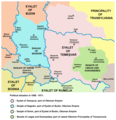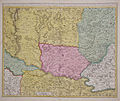Temeşvar Eyalet
| Preceded by | Succeeded by | ||||
|
|
Serbia
Hungary
The Province of Temeşvar (Ottoman Turkish: ;ایالت طمشوار Eyālet-i Tımışvār)[2] was a first-level administrative unit (eyalet) of the Ottoman Empire. It existed from 1552 to 1716. Provincial administration was centered in Temeşvar (today's Timișoara) from 1552 to 1659, and again from 1693 to 1716. During the 1659-1693 interval, its second capital was Yanova (today's Ineu), and within that period, it was also known as the Province of Yanova. The province was located in the Banat region of Central Europe. Besides Banat, it also included southern parts of the Crișana region, north of the Mureș River. Its territory is now divided between Hungary, Romania, and Serbia.[3][4][5]
Names

The name of the province in Ottoman Turkish was Eyâlet-i Temeşvar or Eyâlet-i Tımışvar (in Modern Turkish: Temeşvar Eyaleti or Tamışvar Eyaleti), in Hungarian was Temesvári vilajet, in Romanian was Eialetul Timișoarei or Pașalâcul Timișoara, in Serbian was Темишварски ејалет or Temišvarski ejalet. The province was named after its administrative seat, Temeşvar. The Turkish name Temeşvar is given after the Hungarian one, Temesvár meaning "Castle on the Temes" (River).
History


Upon the initial dissolution of the Eastern Hungarian Kingdom in the summer of 1551, much of its territories, including the Temes County and the surrounding regions, were integrated into the Habsburg Kingdom of Hungary, thus provoking the reaction of the Ottoman Empire, that invaded the region in the autumn of the same year, taking several cities, but not being able to conquer Temeşvar.[6]
The Eyalet of Temeşvar was formed in 1552, when the Hungarian castle of Temesvár defended by the troop of István Losonczy was finally captured by the Ottoman troops led by Kara Ahmed Pasha on July 26, 1552.[7]
The Eyalet was led by a vali (governor) or beylerbey (sometimes with position of pasha or vizir), whose residence was at the former Hunyadi Castle in Temeşvar (1552-1659 and 1693-1716), and also in Yanova (1659-1693).[1]
It existed until 1716, when its territory was conquered by the Habsburg monarchy during the Austro-Turkish War (1716–1718). In 1718, the Habsburgs formed a new province in this region, named the Banat of Temeswar.[8]
-
 The Eyalet of Temeşvar and Banate of Lugos and Karansebes in 1568
The Eyalet of Temeşvar and Banate of Lugos and Karansebes in 1568 -
 The Temeşvar Eyalet, mid-17th century
The Temeşvar Eyalet, mid-17th century -
 The Eyalet of Temeşvar in 1699
The Eyalet of Temeşvar in 1699 -
 Map from 1700 (Eyalet of Temeşvar depicted in red)
Map from 1700 (Eyalet of Temeşvar depicted in red)
Administrative divisions
Upon creation in 1552, the Eyalet of Temeşvar was divided into these sanjaks:
- Sanjak of Tımışvar (Timișoara)
- Sanjak of Arad (seat transferred to Güle (Gyula) in 1566, thus being renamed as the Sanjak of Güle)[3]
- Sanjak of Çanad (Cenad, formed by expanding the Sanjak of Beçkerek (Bečkerek/Zrenjanin that was initially created in 1551)[9][10]
- Sanjak of Lipva (Lipova)
- Sanjak of Modava (Moldova Nouă)
By the end of the 16th century new sanjaks were created:
- Sanjak of Pankota (Pâncota, created in 1565, seat transferred to Yanova (Ineu) in c. 1574)[11]
- Sanjak of Orşova (Orșova)
During the 17th century additional sanjaks were created:
- Sanjak of Fenlak (Felnac)
- Sanjak of Çakova (Ciacova)
- Sanjak of Lagoş (Lugoj, created in 1658)
- Sanjak of Şebeş (Caransebeș, created in 1658)
- Sanjak of Pançova (Pančevo, mentioned in 1695)
Sanjaks of Güle, Yanova and Fenlak, and northern parts of the Çanad and Lipva sanjaks were transferred to Habsburg Monarchy after signing of the Treaty of Karlowitz (1699).
The eyalet consisted of five sanjaks between 1700 and 1701:[12]
Note: Before the Treaty of Karlowitz, Sanjak of Segedin was part of the Eğri Eyalet. Most of this sanjak (including its administrative center, Segedin) was transferred to the Habsburg monarchy in 1699. Small eastern part of the sanjak on the left bank of the river Tisa remained within Ottoman Empire. | According to Sancak Tevcih Defteri, the eyalet consisted of six sanjaks between 1701 and 1702:[12]
| The eyalet consisted of three sanjaks between 1707 and 1713:[12]
|
Governors
This list is incomplete; you can help by adding missing items. (March 2016) |
- Kazim-bey or Gazi Kasim-pasha (1552–1554)[13]
- Hasan-pasha (1594)[14]
- Sofi Sinan-pasha (1594)[15]
- Hasan-pasha, the younger (1594)[16]
- Mustafa Pasha (fl. July 1594)
- Dželalija Hasan-paša (1604–1605)
- Ahmed-paša Dugalić (1605–)
- Ibrahim-pasha (1687)[17]
- Ibrahim-pasha (1701-)[18]
See also
References
- ^ a b Kolçak 2020, p. 77.
- ^ "Some Provinces of the Ottoman Empire". Geonames.de. Retrieved 25 February 2013.
- ^ a b Dávid 1994, p. 143-162.
- ^ Dávid 1999, p. 113-128.
- ^ Kolçak 2020, p. 69-86.
- ^ Dávid & Fodor 1994.
- ^ a b Sadık Müfit Bilge, "Macaristan'da Osmanlı Hakimiyetinin ve İdarî Teşkilatının Kuruluşu ve Gelişmesi", Ankara Üniversitesi Osmanlı Tarihi Araştırma ve Uygulama Merkezi Dergisi (OTAM), Sayı: 11 Sayfa: 033-081, 2000, p. 59. (in Turkish)
- ^ Dabić 2011, p. 191-208.
- ^ Káldy-Nagy 2000.
- ^ Dávid 2000, p. 287.
- ^ Fodor 1999, p. 67-86.
- ^ a b c Kılıç 1997, p. 48-49.
- ^ Milan Tutorov, Banatska rapsodija, Novi Sad, 2001, page 151.
- ^ Milan Tutorov, Banatska rapsodija, Novi Sad, 2001, page 194.
- ^ Milan Tutorov, Banatska rapsodija, Novi Sad, 2001, page 195.
- ^ Milan Tutorov, Banatska rapsodija, Novi Sad, 2001, page 198.
- ^ Milan Tutorov, Banatska rapsodija, Novi Sad, 2001, page 232.
- ^ Milan Tutorov, Banatska rapsodija, Novi Sad, 2001, page 249.
Sources
- Dabić, Vojin S. (2011). "The Habsburg-Ottoman War of 1716-1718 and Demographic Changes in the War-Afflicted Territories". The Peace of Passarowitz, 1718. West Lafayette: Purdue University Press. pp. 191–208.
- Dávid, Géza; Fodor, Pál, eds. (1994). Hungarian-Ottoman Military and Diplomatic Relations in the Age of Süleyman the Magnificent. Budapest: Loránd Eötvös University, Hungarian Academy of Sciences, Institute of History.
- Dávid, Géza (1994). "The Sancakbegis of Arad and Gyula". Acta Orientalia Academiae Scientiarum Hungaricae. 46 (1992–1993): 143–162.
- Dávid, Géza (1999). "The Eyalet of temesvár in the Eighteenth Century". Oriente Moderno. 79 (18): 113–128.
- Dávid, Géza (2000). "An Ottoman Military Career on the Hungarian Borders: Kasim Voyvoda, Bey, and Pasha". Ottomans, Hungarians, and Habsburgs in Central Europe: The Military Confines in the Era of Ottoman Conquest. Leden-Boston-Köln: Brill. pp. 265–297.
- Fodor, Pál (1999). "Who should obtain the castle of Pankota (1565)? Interest groups and self-promotion in the mid-sixteenth-century Ottoman political establishment". Turcica. 31: 67–86.
- Káldy-Nagy, Gyula (2000). A csanádi szandzsák 1567. és 1579. évi összeírása. Szeged: Csongrád Megyei Levéltár.
- Kılıç, Orhan (1997). 18. Yüzyılın İlk Yarısında Osmanlı Devleti'nin İdari Taksimatı: Eyalet ve Sancak Tevcihatı. Elazığ: Şark Pazarlama.
- Kolçak, Özgür (2020). "Köprülü enterprises in Yanova ([Boros]Jenő/Ineu) and Varad ([Nagy]Várad/Oradea): Consolidating Ottoman power and accumulating family wealth (1657-1664)". Archivum Ottomanicum. 37: 69–86.
Further reading
- Gavrilović, Slavko (1993). "Serbs in Hungary, Slavonia and Croatia in struggles against the Turks (15th-18th centuries)". Serbs in European Civilization. Belgrade: Nova, Serbian Academy of Sciences and Arts, Institute for Balkan Studies. pp. 41–54.
- Hegyi, Klára (2000). "The Ottoman Network of Fortresses in Hungary". Ottomans, Hungarians, and Habsburgs in Central Europe: The Military Confines in the Era of Ottoman Conquest. Leden-Boston-Köln: Brill. pp. 163–193.
External links
- Province of Temeşvar in 1600 – Map
- Province of Temeşvar in 1700 – Map
- Province of Temeşvar – Map
- Province of Temeşvar – Map
- Province of Temeşvar – Map
- v
- t
- e
c. 1365 – 1867 (eyalets) | |||||||||||||
|---|---|---|---|---|---|---|---|---|---|---|---|---|---|
| |||||||||||||
1867–1922 (vilayets and mutasarrıfates) | |||||||||||||
|---|---|---|---|---|---|---|---|---|---|---|---|---|---|
| |||||||||||||
Vassals and autonomies | |
|---|---|
















